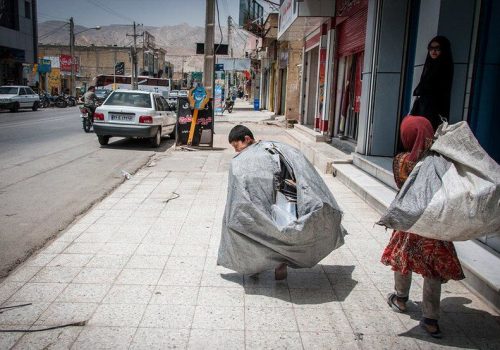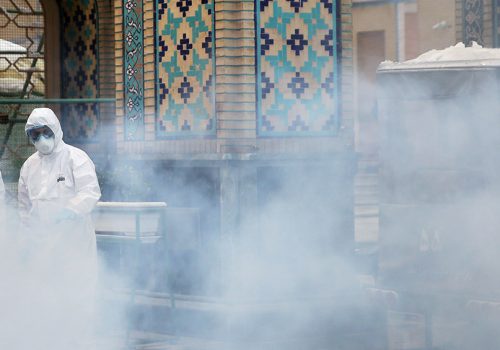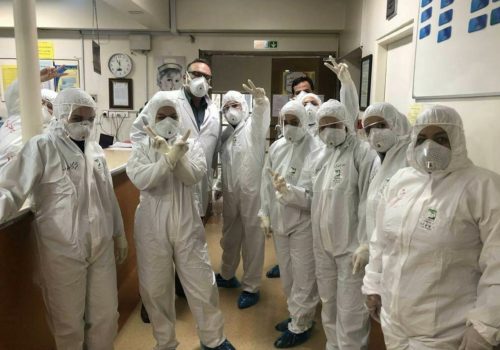Iran’s COVID-19 deaths ‘2.5 times higher’ than health ministry numbers
On November 17, the number of single vaccine doses administered in Iran passed one hundred million. A health ministry official said roughly 80 percent of Iranians above the age of twelve have had at least one dose and 60 percent of that group are fully vaccinated. Despite these reassuring statistics, Iran—which already has the highest number of deaths and cases in the Middle East—appears to be entering a sixth wave of COVID-19 with no end in sight.
Ideology-driven policies have disadvantaged Iran from the start of the pandemic, which has now killed more than 130,000 people according to official (and highly underreported) statistics. Iranians attribute inadequate testing and a slow rollout of vaccines to policies ordered by Supreme Leader Ayatollah Ali Khamenei. Despite all warnings, the regime has told Iranians to return to normal life, risking a new rise in cases with schools reopened and workers returning to their offices.
The outbreak was initially covered up because the religious center of Qom was the first hotspot for the pandemic and because the leadership didn’t want to postpone the February 2020 parliamentary elections. Outright falsehoods by then-Health Minister Saeed Namaki and President Hassan Rouhani, who boasted of imaginary successes in fighting the pandemic, worsened the situation.
Then-President Donald Trump’s belated blaming of China also helped the regime oversimplify the pandemic to a power struggle among world leaders not related to Iran. However, when the international shockwaves subsided and the pandemic became impossible to ignore or blame on others, Iran’s decision-making system proved incapable of setting effective policies for controlling the disease’s spread.
Lockdown wasn’t an option because Iran was already suffering from a deep recession, high unemployment, and US sanctions. Luckily, the first wave coincided with the Nowruz holidays in March 2020, but Iran couldn’t control future outbreaks.
Vaccine hypocrisy
The government didn’t have sufficient funds to pre-order or invest in vaccines, while vaccine-developing countries didn’t sell to Iran—at least in the early months. Even China and Russia had reservations because primary raw materials were US-made. So, Iran decided to opt for domestic development of a vaccine.
The state-owned Barakat Foundation started its work when other producers were already in phases two or three of vaccine development. The foundation and health ministry announced several dates and even numbers of vaccines to be delivered, such as fifty million doses by the end of summer 2021, but this turned out to be costly propaganda that prevented the import of vaccines even for medical staff.
There was also a political fight over whether Iran should buy Western or Russian and Chinese vaccines, with Khamenei personally intervening to ban US and UK-made doses in January. In addition, there was a wave of disinformation by anti-vaccine clerics to “stop treating Iranian people like laboratory rats.” In the fall of 2020, Turkey and the United Arab Emirates (UAE) agreed to test the third phase of China’s Sinopharm in trials. But Rouhani was not ready to take the risk of alienating powerful clerics. In addition, his government couldn’t provide a down payment for the Chinese and Russian vaccines and others provided by the COVAX consortium, fearing that US sanctions would block both funds and the source of funding. While Turkey and the UAE used the Chinese Sinopharm vaccine to control the pandemic successfully, Iran lost precious time.
Khamenei’s ban on US and UK vaccines encouraged domestic opposition to all vaccines. In January, some 2,500 medical doctors from the hardliners’ camp—including current Health Minister Bahram Einollahi and his two top deputies—protested importing vaccines or investing in their production abroad.
The result was a fourth and fifth wave of COVID-19 in the first half of 2021, with Iran not just having the largest numbers of cases and deaths in the Middle East since the pandemic began, but also being the least vaccinated country in the region. In August, public pressure on the Supreme Leader finally forced him to end his ban on imports and suppress the anti-vaccination campaigns (with the caveat that Western vaccines not be made in the US and United Kingdom). Meanwhile, Ebrahim Raisi won the June presidential election and the same hardliners and clerics that had opposed vaccination rushed to import vaccines from whatever source available and start mass vaccination in the fall.
Numbers exceed what is being officially reported
Excess mortality is a term that refers to the number of deaths during a crisis above and beyond expected under ‘normal’ conditions. Technical studies carried out on excess mortality among Iranians conclude that “the death rate related to COVID-19 is 2.5 times higher than the statistics announced by the health ministry,” according to a report published in April by the International Journal of Infectious Diseases.
Iran’s National Organization for Civil Registration reports the number of deaths across Iran on a weekly basis. Its statistics show that Iran has experienced roughly 257,000 excess deaths from the beginning of the pandemic in January 2020 to the end of summer 2021. In these twenty-one months, roughly 915,000 people have passed away. The corresponding figure for 21-month periods in previous years was about 658,000.
The number of cases and, therefore, the rate of infection and positive tests are also underreported because there has been a lack of testing materials. The number of tests per one thousand people has never been above 1.5 in Iran since the beginning of the outbreak. The corresponding number for other countries in the region has been between 2.5 and 3.5.
According to my calculations, the ratio of confirmed positive tests to the total number of tests has always been dangerously high in Iran—sometimes above 46 percent, meaning that 4 to 5 persons out of every ten Iranians were virus-positive. The rate has been falling for two months and has stabilized at around 8 to 10 percent. The corresponding rate in Iran’s Arab neighbors is 1 to 2.2 percent.
The number of cases per 100,000 people had been double-digit until early November and fell to a single-digit level only two weeks ago. The number of daily tests was around 25,000 a day in August 2020 and gradually increased to 105,000-110,000 in August 2021. Had the testing rate been at the 3 percent regional average, the total number of cases In Iran should have been near thirteen million, or more than two times the 6,069,559 cases reported by the health ministry on November 19. These higher figures also support an excess mortality ratio of 220 percent.
That said, the general trends of the daily numbers reported by the health ministry and the movements of the indices can be considered correct. No one can be certain of the correctness of absolute numbers unless and until the number of daily tests increases to an acceptable range. However, the trend of daily cases clearly indicates an end of the fifth wave, with a falling number of cases and fatalities.
But the danger isn’t over yet. With the reopening of schools and universities, high-risk businesses like movie theatres, and growing international concern over the omicron variant, Iranians are hearing constant warnings—even from within the regime—that such policies are wrong and need to be revised. Otherwise, a sixth wave of rising cases and fatalities will be inevitable.
The author, who is well versed in the Iranian political scene, asked to remain anonymous.
Further reading
Thu, Aug 13, 2020
Coronavirus pandemic exacerbates Iran’s child abuse problem
IranSource By
Lack of healthy communication and parenting skills, coupled with a sense of unknowing and fear during the pandemic, have increased stress and tensions at home.
Mon, May 4, 2020
Even a coronavirus pandemic can’t save religion in Iran
IranSource By
41 years after the Islamic Revolution, the public’s confidence in the religious establishment, which is perceived by many Iranians as responsible for their hardships, has eroded.
Tue, Feb 25, 2020
Cover-ups and incompetence: Iran as the Middle East’s coronavirus epicenter
IranSource By
For now, Iran has not banned its citizens from traveling to China, which as of midnight on February 25 has confirmed nearly 65,000 infections within its border.
Image: An Iranian nurse attends to patient suffering from COVID-19 at a hospital as the coronavirus disease (COVID-19) cases spike, in Tehran, Iran July 28, 2021. Majid Asgaripour/WANA (West Asia News Agency) via REUTERS


